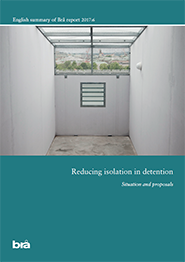- Start
- / Home
- / Publications

Reducing isolation in detention
Situation and proposals. English summary of Brå report 2017:6
Sweden has been the object of criticism because a significant number of persons in detention are in isolation. This report studies detention and the conditions in Swedish detention centres.
Each year, between 9,000 and 10,000 persons in Sweden are held in detention. The average detention period is two months and, in 2015, almost 500 persons were in detention for at least six months. Slightly more than two-thirds of the persons in detention are subject to restrictions which isolate them from both the outside world and from other persons in detention. Of the persons who were in detention in 2015, 140 were children between 15 and 17 years of age. They are customarily detained for a shorter period than adults and, on the average, for one month.
On the other hand, it is more common for this group than for adults to be subject to restrictions – specifically, in a full 81% of the cases. Since the 1990s, Sweden has been the object of criticism from both the UN and the Council of Europe because such a significant number of persons in detention are in isolation by virtue of a decision regarding restrictions. The UN Committee on the Rights of the Child has also criticised Sweden’s isolation of children who are placed in detention and custody, and has exhorted Sweden to immediately cease isolation for all children and to amend its legislation to prohibit the isolation of children.
In this light, the Government appointed several committees during 2015 in respect of detention and the conditions in Swedish detention centres. The Detention and Restrictions Committee (Häktes- och restriktionsutredningen) was appointed for the purpose of submitting proposals aimed at reducing the use of detention and restrictions. The committee submitted its report in August of 2016. In addition, Brå was instructed to study detention and conditions in detention centres, which is the subject of this report.
© The Swedish National Council for Crime Prevention, 2017
Authors: Klara Hradilova-Selin and Stina Holmberg
urn:nbn:se:bra-696

